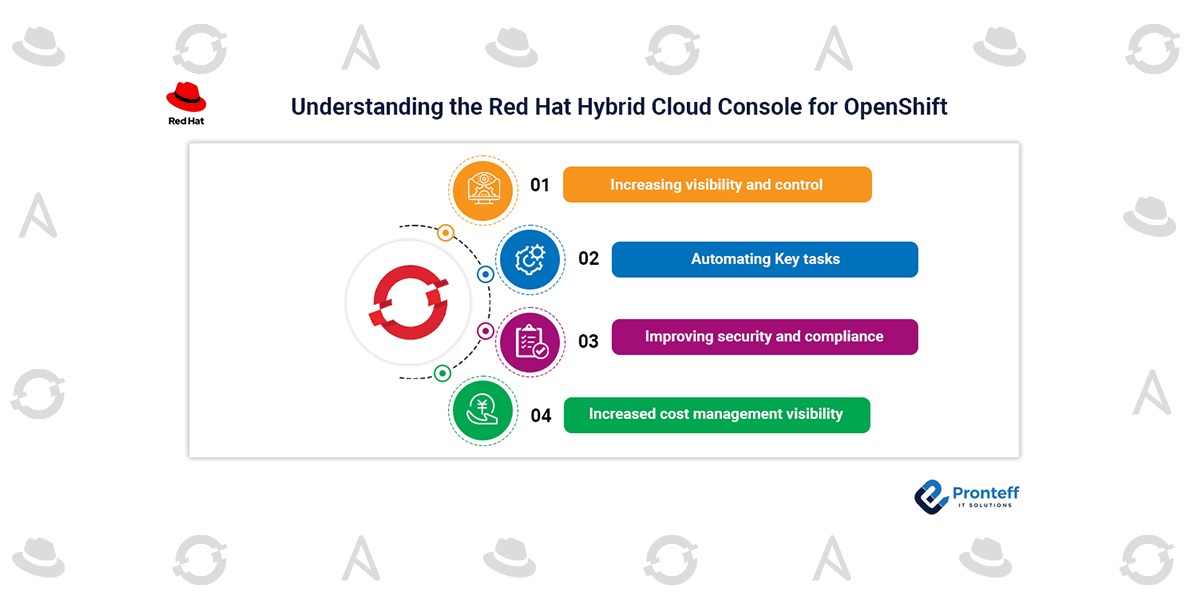Understanding the Red Hat Hybrid Cloud Console for OpenShift
There is a solid web-based management interface called the Red Hat Hybrid Cloud Console for all of your Red Hat Hybrid Cloud products. Red Hat infrastructure, such as Red Hat OpenShift, Red Hat Enterprise Linux, and Red Hat Ansible Automation Platform, can be managed using the console.

A customer does not need to deploy any infrastructure in order to use the Red Hat Hybrid Cloud Console because it is a cloud-based service. It offers a user interface (UI) that is simple to use, thoughtfully built, and enables a wide range of operations throughout your entire organization.
You receive a centralized view of your hybrid cloud environment, allowing you to control and automate infrastructure, apps, and deployments from a single location.
Here are some pointers for utilizing the Red Hat Hybrid Cloud Console to manage your Red Hat OpenShift clusters in just about any setting.
Features and advantages of the OpenShift console
For maintaining the health, security, and management of your OpenShift fleet, the Hybrid Cloud Console offers strong advantages and features, such as:
Increasing visibility and control:
Having a centralized view of your hybrid cloud environment allows you to manage both on-premises bare-metal and virtual environments as well as cloud-based self-managed and fully managed environments.
Automating critical positions:
Red Hat Ansible enables you to automate operations, monitoring, and configuration processes. The Hybrid Cloud Console offers a single, user-friendly dashboard with stylish, practical, and helpful views for deeper insights into your automation. Automation frees up staff to concentrate on more strategic and business-critical activities.
Enhancing security and compliance:
Features like role-based access control, effective subscription management, visibility and analysis of CVEs and vulnerabilities, and best practice suggestions improve the security and compliance of your systems.
Increased cost management visibility:
Gain insights to better understand and control costs, including those associated with Red Hat infrastructure and that of cloud service providers like AWS, Google Compute Cloud, and Microsoft Azure.
Even managed OpenShift deployments like ROSA can be installed using the console’s built-in wizards on cloud providers.

Additionally, it incorporates Assisted Installer installs to make setting up bare-metal environments for your on-premises physical OpenShift clusters simpler.

It’s a one-stop shop that puts you in control from the ground up!
Track cluster health and status
In order to construct, manage, and maintain your entire fleet, the Red Hat Hybrid Cloud Console offers a single view into your OpenShift clusters regardless of the environment in which they are running.

The Hybrid Cloud Console’s gorgeously designed and seamlessly connected dashboards make it simple to see the fleet’s condition. With a few simple clicks, you can easily evaluate telemetry, cost management, subscription management, and security scanning.

Even better, you can use the Hybrid Cloud Console to track usage and expenditures for your accounts on external cloud platforms like AWS, Google Cloud Platform, and Microsoft Azure.

Additionally, with Red Hat Insights for OpenShift integrated, you get built-in best practice recommendations from Red Hat to keep your clusters operating efficiently, backed by the most recent Red Hat guidance.

With graphical views of outstanding CVEs, their severity level, and precisely which clusters need your attention, Insights also provides in-depth research of the security landscape of your clusters.

Try it out today!
All of this is included in your Red Hat OpenShift subscription and is now connected to your Red Hat account.
To view the Red Hat Hybrid Cloud in action on your account right now, login using your Red Hat login at https://cloud.redhat.com.
Managing your Open Hybrid Cloud has never been simpler thanks to the Red Hat Hybrid Cloud Console!








